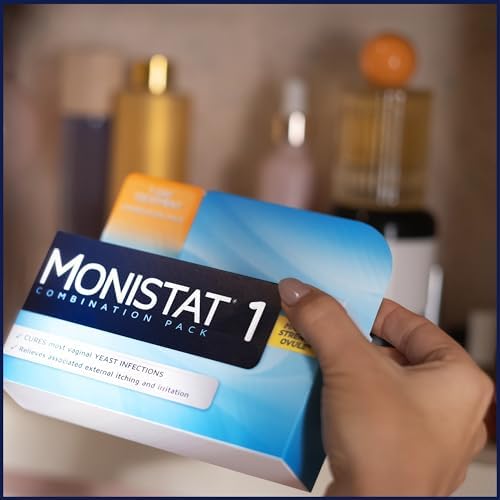Monistat 1 is a popular over-the-counter antifungal treatment used to treat yeast infections. While it is effective in relieving symptoms such as itching, burning, and discharge, many users wonder how long they should wait after using Monistat 1 before engaging in intercourse. This article provides a comprehensive guide on the recommended waiting period, the reasons behind it, and tips to ensure the treatment works effectively.
Understanding Monistat 1: What Is It and How Does It Work?
Monistat 1 is an antifungal medication containing the active ingredient tioconazole, which works by stopping the growth of yeast that causes infections. It is available in a single-dose ovule form that is inserted vaginally, allowing for direct contact with the affected area. The treatment is designed to release the medication slowly, providing continuous relief over several days.
1. Why Use Monistat 1?
Monistat 1 is often chosen for its convenience, as it requires only a single dose, making it easier for those who prefer a quick and simple treatment option. The medication is known to effectively treat yeast infections, usually clearing symptoms within a few days.
2. How Monistat 1 Works
The active ingredient, tioconazole, penetrates the vaginal lining and targets the yeast cells, disrupting their cell membranes and stopping their growth. The medication continues to work even after the initial dose, which is why it is crucial to follow the recommended guidelines for activity restrictions, including intercourse.
How Long After Using Monistat 1 Can I Have Intercourse?
It is generally recommended to wait at least 3 to 7 days after using Monistat 1 before engaging in vaginal intercourse. This waiting period allows the medication to be fully absorbed and ensures it remains effective in treating the infection.
1. Why Wait Before Having Intercourse?
There are several reasons why it is advisable to wait before having intercourse after using Monistat 1:
- Ensure Effectiveness: Engaging in intercourse too soon after applying Monistat 1 can cause the medication to be removed or diluted, reducing its effectiveness in treating the infection.
- Avoid Irritation: The vaginal tissues may be sensitive due to the infection and the medication. Intercourse can cause additional irritation, leading to discomfort or worsening symptoms.
- Prevent Transmission: Yeast infections can be transmitted between partners. Waiting allows the medication to clear the infection, reducing the risk of passing it on.
2. Factors That May Affect the Waiting Period
While the general recommendation is to wait 3 to 7 days, the exact duration can vary depending on several factors:
- Severity of Infection: For more severe infections, it may be necessary to wait longer to ensure complete healing and avoid re-infection.
- Personal Sensitivity: Some individuals may experience more sensitivity or irritation and may need to wait longer before feeling comfortable enough for intercourse.
Signs That It’s Safe to Resume Intercourse
Knowing when it is safe to resume intercourse is important for both comfort and effective treatment. Here are some signs to look for:
1. Absence of Symptoms
Before resuming intercourse, ensure that all symptoms of the yeast infection, such as itching, burning, and discharge, have fully subsided. Continuing symptoms may indicate that the infection is not completely cleared.
2. No Pain or Discomfort
If you experience any pain, discomfort, or irritation, it’s best to wait a little longer. Your body needs time to heal, and engaging in intercourse too soon can cause further irritation.
3. Follow-Up with Your Healthcare Provider
If you are unsure whether it is safe to resume intercourse or if symptoms persist, consult your healthcare provider for guidance. They can provide personalized advice based on your specific situation.
Tips for Ensuring Effective Treatment with Monistat 1
To maximize the effectiveness of Monistat 1 and ensure a smooth recovery, consider the following tips:
1. Follow Application Instructions Carefully
Proper application is key to ensuring the medication works effectively.
- Insert the Ovule Correctly: Make sure to insert the Monistat 1 ovule as directed, usually at bedtime, to allow it to remain in place and work effectively overnight.
- Avoid Interference: Refrain from douching, using tampons, or inserting any other products vaginally while using Monistat 1, as these can interfere with the medication’s effectiveness.
2. Wear Loose, Comfortable Clothing
Tight clothing can cause friction and increase irritation, making symptoms worse. Opt for loose, breathable fabrics like cotton to keep the vaginal area dry and comfortable.
3. Stay Hydrated and Maintain Good Hygiene
Drinking plenty of water and maintaining good hygiene can help support your body’s natural healing processes.
- Hydration: Staying hydrated helps flush out toxins and supports overall health.
- Hygiene: Gently wash the vaginal area with mild soap and water, and avoid using harsh chemicals or scented products that could irritate the skin.
What to Do If Symptoms Persist
If you find that your symptoms have not improved after the recommended waiting period or if they worsen, it may be necessary to consult your healthcare provider. They can help determine whether the infection requires additional treatment or if another condition is present.
1. Possible Reasons for Persistent Symptoms
Persistent symptoms may be due to several reasons, including:
- Incomplete Treatment: The infection may require more than one dose of medication to be fully cleared.
- Misdiagnosis: The symptoms could be due to a different type of infection, such as bacterial vaginosis or a sexually transmitted infection (STI), which requires a different treatment approach.
- Allergic Reaction: Some individuals may have an allergic reaction to the active ingredient in Monistat 1, leading to increased irritation.
Conclusion
It is generally recommended to wait 3 to 7 days after using Monistat 1 before having intercourse to ensure the medication’s effectiveness and avoid irritation. Understanding the reasons behind this waiting period and following the recommended guidelines can help ensure a smooth recovery from a yeast infection. If symptoms persist or you have concerns, consult your healthcare provider for further advice.
Disclaimer: The content on Wellness Derive is for informational purposes only and not a substitute for professional medical advice, diagnosis, or treatment. Always consult a healthcare provider for medical concerns.



